Dongning Ma
Evaluating and Enhancing Robustness of Deep Recommendation Systems Against Hardware Errors
Jul 17, 2023



Abstract:Deep recommendation systems (DRS) heavily depend on specialized HPC hardware and accelerators to optimize energy, efficiency, and recommendation quality. Despite the growing number of hardware errors observed in large-scale fleet systems where DRS are deployed, the robustness of DRS has been largely overlooked. This paper presents the first systematic study of DRS robustness against hardware errors. We develop Terrorch, a user-friendly, efficient and flexible error injection framework on top of the widely-used PyTorch. We evaluate a wide range of models and datasets and observe that the DRS robustness against hardware errors is influenced by various factors from model parameters to input characteristics. We also explore 3 error mitigation methods including algorithm based fault tolerance (ABFT), activation clipping and selective bit protection (SBP). We find that applying activation clipping can recover up to 30% of the degraded AUC-ROC score, making it a promising mitigation method.
NasHD: Efficient ViT Architecture Performance Ranking using Hyperdimensional Computing
Sep 23, 2022


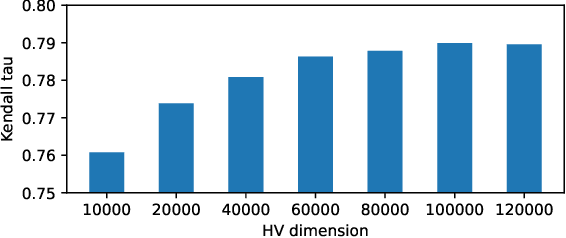
Abstract:Neural Architecture Search (NAS) is an automated architecture engineering method for deep learning design automation, which serves as an alternative to the manual and error-prone process of model development, selection, evaluation and performance estimation. However, one major obstacle of NAS is the extremely demanding computation resource requirements and time-consuming iterations particularly when the dataset scales. In this paper, targeting at the emerging vision transformer (ViT), we present NasHD, a hyperdimensional computing based supervised learning model to rank the performance given the architectures and configurations. Different from other learning based methods, NasHD is faster thanks to the high parallel processing of HDC architecture. We also evaluated two HDC encoding schemes: Gram-based and Record-based of NasHD on their performance and efficiency. On the VIMER-UFO benchmark dataset of 8 applications from a diverse range of domains, NasHD Record can rank the performance of nearly 100K vision transformer models with about 1 minute while still achieving comparable results with sophisticated models.
Hyperdimensional Computing vs. Neural Networks: Comparing Architecture and Learning Process
Jul 24, 2022


Abstract:Hyperdimensional Computing (HDC) has obtained abundant attention as an emerging non von Neumann computing paradigm. Inspired by the way human brain functions, HDC leverages high dimensional patterns to perform learning tasks. Compared to neural networks, HDC has shown advantages such as energy efficiency and smaller model size, but sub-par learning capabilities in sophisticated applications. Recently, researchers have observed when combined with neural network components, HDC can achieve better performance than conventional HDC models. This motivates us to explore the deeper insights behind theoretical foundations of HDC, particularly the connection and differences with neural networks. In this paper, we make a comparative study between HDC and neural network to provide a different angle where HDC can be derived from an extremely compact neural network trained upfront. Experimental results show such neural network-derived HDC model can achieve up to 21% and 5% accuracy increase from conventional and learning-based HDC models respectively. This paper aims to provide more insights and shed lights on future directions for researches on this popular emerging learning scheme.
EnHDC: Ensemble Learning for Brain-Inspired Hyperdimensional Computing
Mar 25, 2022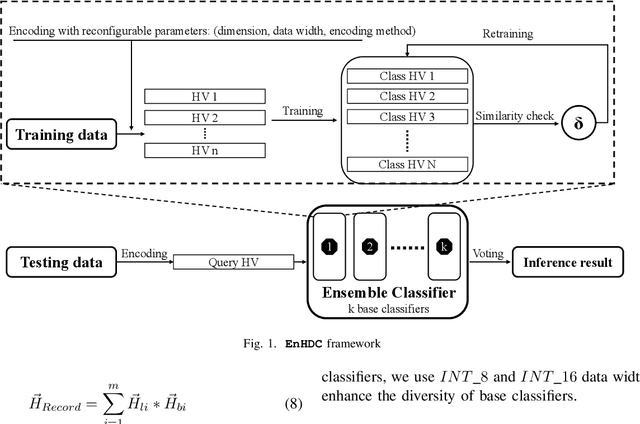
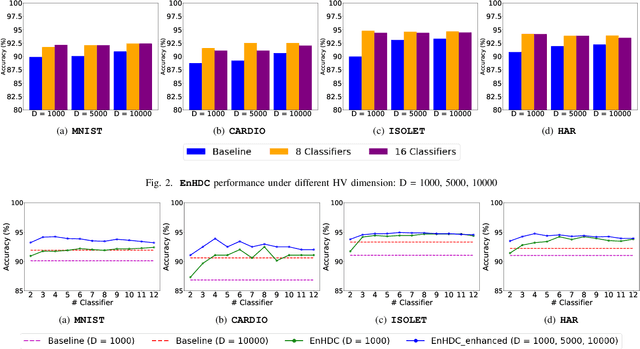
Abstract:Ensemble learning is a classical learning method utilizing a group of weak learners to form a strong learner, which aims to increase the accuracy of the model. Recently, brain-inspired hyperdimensional computing (HDC) becomes an emerging computational paradigm that has achieved success in various domains such as human activity recognition, voice recognition, and bio-medical signal classification. HDC mimics the brain cognition and leverages high-dimensional vectors (e.g., 10000 dimensions) with fully distributed holographic representation and (pseudo-)randomness. This paper presents the first effort in exploring ensemble learning in the context of HDC and proposes the first ensemble HDC model referred to as EnHDC. EnHDC uses a majority voting-based mechanism to synergistically integrate the prediction outcomes of multiple base HDC classifiers. To enhance the diversity of base classifiers, we vary the encoding mechanisms, dimensions, and data width settings among base classifiers. By applying EnHDC on a wide range of applications, results show that the EnHDC can achieve on average 3.2\% accuracy improvement over a single HDC classifier. Further, we show that EnHDC with reduced dimensionality, e.g., 1000 dimensions, can achieve similar or even surpass the accuracy of baseline HDC with higher dimensionality, e.g., 10000 dimensions. This leads to a 20\% reduction of storage requirement of HDC model, which is key to enabling HDC on low-power computing platforms.
HDCoin: A Proof-of-Useful-Work Based Blockchain for Hyperdimensional Computing
Feb 07, 2022Abstract:Various blockchain systems and schemes have been proposed since Bitcoin was first introduced by Nakamoto Satoshi as a distributed ledger. However, blockchains usually face criticisms, particularly on environmental concerns as their ``proof-of-work'' based mining process usually consumes a considerable amount of energy which hardly makes any useful contributions to the real world. Therefore, the concept of ``proof-of-useful-work'' (PoUW) is proposed to connect blockchain with practical application domain problems so the computation power consumed in the mining process can be spent on useful activities, such as solving optimization problems or training machine learning models. This paper introduces HDCoin, a blockchain-based framework for an emerging machine learning scheme: the brain-inspired hyperdimensional computing (HDC). We formulate the model development of HDC as a problem that can be used in blockchain mining. Specifically, we define the PoUW under the HDC scenario and develop the entire mining process of HDCoin. During mining, miners are competing to obtain the highest test accuracy on a given dataset. The winner also has its model recorded in the blockchain and are available for the public as a trustworthy HDC model. In addition, we also quantitatively examine the performance of mining under different HDC configurations to illustrate the adaptive mining difficulty.
MoleHD: Automated Drug Discovery using Brain-Inspired Hyperdimensional Computing
Jun 05, 2021



Abstract:Modern drug discovery is often time-consuming, complex and cost-ineffective due to the large volume of molecular data and complicated molecular properties. Recently, machine learning algorithms have shown promising results in virtual screening of automated drug discovery by predicting molecular properties. While emerging learning methods such as graph neural networks and recurrent neural networks exhibit high accuracy, they are also notoriously computation-intensive and memory-intensive with operations such as feature embeddings or deep convolutions. In this paper, we propose a viable alternative to neural network classifiers. We present MoleHD, a method based on brain-inspired hyperdimensional computing (HDC) for molecular property prediction. We first transform the SMILES presentation of molecules into feature vectors by SMILE-PE tokenizers pretrained on the ChEMBL database. Then, we develop HDC encoders to project such features into high-dimensional vectors that are used for training and inference. We perform an extensive evaluation using 30 classification tasks from 3 widely-used molecule datasets and compare MoleHD with 10 baseline methods including 6 SOTA neural network classifiers. Results show that MoleHD is able to outperform all the baseline methods on average across 30 classification tasks with significantly reduced computing cost. To the best of our knowledge, we develop the first HDC-based method for drug discovery. The promising results presented in this paper can potentially lead to a novel path in drug discovery research.
HDXplore: Automated Blackbox Testing of Brain-Inspired Hyperdimensional Computing
May 26, 2021



Abstract:Inspired by the way human brain works, the emerging hyperdimensional computing (HDC) is getting more and more attention. HDC is an emerging computing scheme based on the working mechanism of brain that computes with deep and abstract patterns of neural activity instead of actual numbers. Compared with traditional ML algorithms such as DNN, HDC is more memory-centric, granting it advantages such as relatively smaller model size, less computation cost, and one-shot learning, making it a promising candidate in low-cost computing platforms. However, the robustness of HDC models have not been systematically studied. In this paper, we systematically expose the unexpected or incorrect behaviors of HDC models by developing HDXplore, a blackbox differential testing-based framework. We leverage multiple HDC models with similar functionality as cross-referencing oracles to avoid manual checking or labeling the original input. We also propose different perturbation mechanisms in HDXplore. HDXplore automatically finds thousands of incorrect corner case behaviors of the HDC model. We propose two retraining mechanisms and using the corner cases generated by HDXplore to retrain the HDC model, we can improve the model accuracy by up to 9%.
HDTest: Differential Fuzz Testing of Brain-Inspired Hyperdimensional Computing
Mar 15, 2021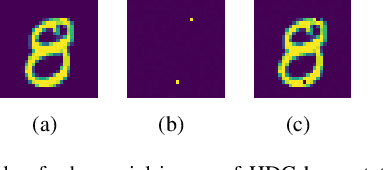
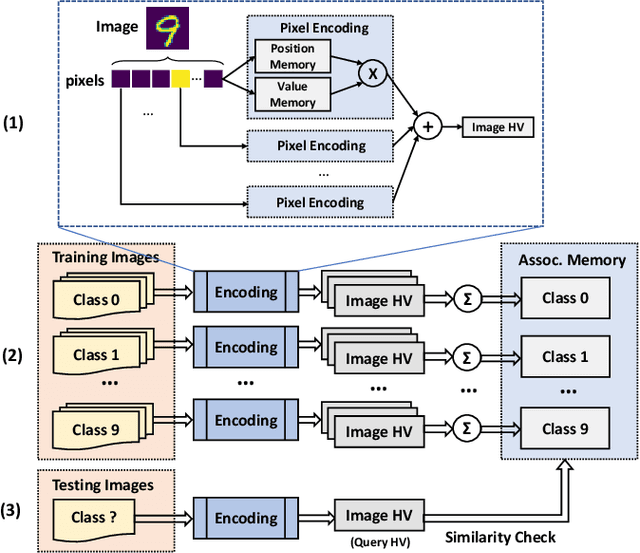
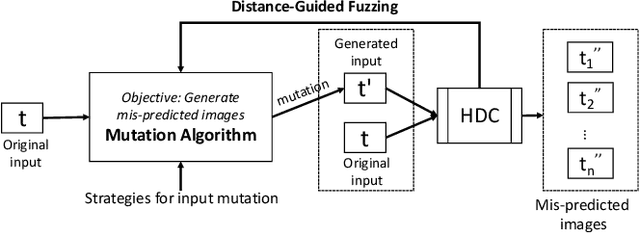
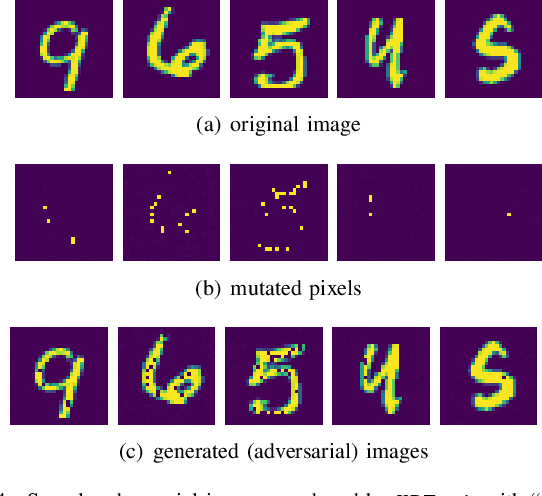
Abstract:Brain-inspired hyperdimensional computing (HDC) is an emerging computational paradigm that mimics brain cognition and leverages hyperdimensional vectors with fully distributed holographic representation and (pseudo)randomness. Compared to other machine learning (ML) methods such as deep neural networks (DNNs), HDC offers several advantages including high energy efficiency, low latency, and one-shot learning, making it a promising alternative candidate on a wide range of applications. However, the reliability and robustness of HDC models have not been explored yet. In this paper, we design, implement, and evaluate HDTest to test HDC model by automatically exposing unexpected or incorrect behaviors under rare inputs. The core idea of HDTest is based on guided differential fuzz testing. Guided by the distance between query hypervector and reference hypervector in HDC, HDTest continuously mutates original inputs to generate new inputs that can trigger incorrect behaviors of HDC model. Compared to traditional ML testing methods, HDTest does not need to manually label the original input. Using handwritten digit classification as an example, we show that HDTest can generate thousands of adversarial inputs with negligible perturbations that can successfully fool HDC models. On average, HDTest can generate around 400 adversarial inputs within one minute running on a commodity computer. Finally, by using the HDTest-generated inputs to retrain HDC models, we can strengthen the robustness of HDC models. To the best of our knowledge, this paper presents the first effort in systematically testing this emerging brain-inspired computational model.
Machine Learning-based Classification of Active Walking Tasks in Older Adults using fNIRS
Feb 10, 2021



Abstract:Decline in gait features is common in older adults and an indicator of disability and mortality. Cortical control of gait, specifically in the pre-frontal cortex as measured by functional near infrared spectroscopy (fNIRS), during dual task walking has shown to be moderated by age, gender, cognitive status, and various age-related disease conditions. In this study, we develop classification models using machine learning methods to classify active walking tasks in older adults based on fNIRS signals into either Single-Task-Walk (STW) or Dual-Task-Walk (DTW) conditions. In this study, we develop classification models using machine learning methods to classify active walking tasks in older adults based on fNIRS signals into either single-task walking (STW) or dual-task walking (DTW). The fNIRS measurements included oxyhemoglobin (HbO2) and deoxyhemoglobin (Hb) signals obtained from prefrontal cortex (PFC) of the subject performing on the ground active walking tasks with or without a secondary cognitive task. We extract the fNIRS-related features by calculating the minimum, maximum, mean, skewness and kurtosis values of Hb and Hbo2 signals. We then use feature encoding to map the values into binary space. Using these features, we apply and evaluate various machine learning methods including logistic regression (LR), decision tree (DT), support vector machine (SVM), k-nearest neighbors (kNN), multilayer perceptron (MLP), and Random Forest (RF). Results showed that the machine learning models can achieve around 97\% classification accuracy.
 Add to Chrome
Add to Chrome Add to Firefox
Add to Firefox Add to Edge
Add to Edge